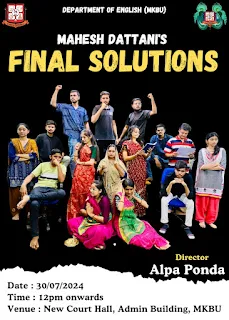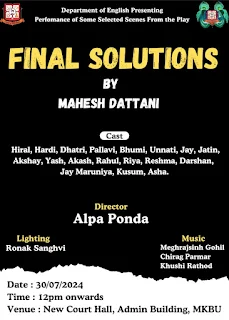This blog is part of the task on Thinking Activity Mahesh Dattani's Final Solutios. Mahesh Dattani's Final Solutios topic was given by professor Miss Prakruti Bhatt. Certainly, here's a unique and intriguing answer so, this blog deals with some of the answers to questions.
Mahesh Dattani’s Final Solutions is a rich tapestry of emotional intensity, cultural conflict, and psychological depth. As a student of theatre, my experience of reading, studying, rehearsing, and performing the play has been transformative. Through its innovative manipulation of time and space, and its exploration of guilt, the play becomes more than a simple story of communal tensions—it becomes a broader meditation on the human experience and a compelling examination of history's lingering wounds. This blog will reflect on that journey while addressing three key questions: Dattani’s use of time and space, the complex emotions of guilt experienced by the characters, and my personal journey through the process of studying and performing the play.
Question 1: Mahesh Dattani’s Manipulation of Time and Space
Mahesh Dattani masterfully manipulates time and space in Final Solutions to create meaning, shifting fluidly between the past and the present, and using stagecraft techniques that engage both the characters and the audience in a powerful dialogue. His manipulation of time is subtle yet effective, interweaving memories with real-time events in a manner that underscores the cyclical nature of communal violence and intergenerational trauma.
The play is structured to represent different timelines, moving between the 1947 partition riots and contemporary communal violence. The temporal shifts, however, are not abrupt; they are gradual, almost seamless, showing how unresolved historical trauma continues to echo into the present. Dattani does not simply flashback to 1947 as a separate entity but uses the characters’ experiences to show how the past is not dead it lives within the present, shaping mindsets, attitudes, and prejudices. This is evident when Daksha's diary entries from 1947 unfold alongside the present-day experiences of the characters, revealing how unresolved feelings of betrayal and fear still resonate.
The manipulation of space in Final Solutions is equally complex and layered. Dattani divides the stage into distinct areas representing different spaces: the home of the Gandhi family, the streets outside, and symbolic elements like the mob that shifts between being an abstract concept and a physical entity on stage. This spatial division allows for simultaneous action, with characters interacting in different areas of the stage at the same time, representing the psychological and emotional distances between them.
One of the most striking stagecraft techniques Dattani employs is the use of a chorus that serves as both the Hindu and Muslim mobs. This chorus is a fluid entity, constantly shifting its identity and its relationship to the main characters, sometimes becoming an extension of the characters’ inner fears and prejudices, and at other times representing the actual physical threat of communal violence. The chorus is a spatial manifestation of the communal tensions that exist outside the family home, yet it also pervades the space within, reminding the audience that no one is immune to the fear and hate that fuel such violence.
The fluidity of space is further emphasized by the lighting design, which Dattani uses to delineate the different time periods and emotional landscapes of the characters. For example, when Daksha reads her diary, the lighting creates a nostalgic atmosphere that transports the audience to her past, but when the mob is present, the lighting becomes harsh, creating a sense of danger and immediacy. This manipulation of light and space creates a visual representation of the characters' psychological states and the historical forces at play.
As a student of theatre, witnessing and engaging in these stagecraft techniques in rehearsals deepened my appreciation for the complexity of Dattani’s work. The use of overlapping time periods and simultaneous actions within different spaces demanded a heightened awareness of both the historical and emotional context of the scenes. It became clear that time and space in Final Solutions are not merely backdrops to the action but are active participants in the creation of meaning, emphasizing the interconnectedness of past and present and the ever-present shadow of communal tensions.
Question 2: The Complexity of Guilt in Final Solutions
Guilt is a pervasive emotion in *Final Solutions*, shaping the actions and relationships of the characters in profound and often destructive ways. Each character carries their own burden of guilt, whether personal or collective, and this guilt drives much of the conflict in the play.
For Daksha, the guilt is deeply personal. Her diary reveals her feelings of guilt and regret over her friendship with Zarine, a Muslim girl, during the time of the partition riots. Daksha's guilt is not just about betraying her friend; it also stems from her internalized prejudices and the realization that her society does not allow for such friendships across communal lines. Her guilt is a manifestation of the broader societal guilt of partition a guilt that remains unresolved and unacknowledged.
Aruna, the mother of the Gandhi family, embodies another form of guilt, one that is tied to religious and moral righteousness. Her guilt is deeply rooted in her fear of religious impurity and her inability to reconcile her sense of duty with her latent prejudices. This guilt prevents her from fully accepting Javed and Bobby, the two Muslim boys who seek refuge in her home, and it strains her relationships with her husband and daughter. Aruna’s guilt is reflective of the broader societal guilt of failing to live up to the ideals of religious tolerance and harmony.
Javed’s guilt is perhaps the most complex. As a young Muslim man who has been involved in acts of communal violence, Javed is both a victim and a perpetrator of the cycle of hate and revenge. His guilt is not only about his actions but also about his inability to break free from the societal expectations placed on him as a Muslim in a Hindu-majority society. This guilt isolates him from others and fuels his anger and resentment, leading to further conflict. Yet, it is also Javed’s guilt that drives him towards self-reflection and, eventually, a desire for reconciliation.
Bobby, in contrast to Javed, experiences guilt in a more subtle way. His guilt is not about his actions but about his identity. As a Muslim man who does not fit the stereotypical image of a communal aggressor, Bobby feels guilty for not conforming to the expectations placed on him by both the Hindu and Muslim communities. His guilt is tied to his sense of alienation and his struggle to assert his individuality in a world that defines people by their religious affiliations.
As I engaged with the characters’ emotions in rehearsals, I found myself reflecting on the multifaceted nature of guilt and how it shapes human behavior. Guilt in Final Solutions is not just a personal emotion; it is a collective one, tied to the broader history of communal conflict in India. The characters’ guilt is a reflection of the nation’s unresolved past, and their attempts to come to terms with it mirror the challenges faced by Indian society in addressing its history of communal violence.
Question 3: My Journey Through Fnal Solutions
Studying, rehearsing, and performing Final Solutions was a deeply enriching experience that shaped my understanding and appreciation of theatre in ways I had not anticipated. The play challenged me to think critically about the role of theatre in addressing social and political issues, and it pushed me to explore the emotional and psychological depths of the characters I portrayed.
In studying the play, I was struck by the layers of meaning embedded in Dattani’s text. His use of symbolism, metaphor, and non-linear narrative structure demanded close reading and analysis. The more I delved into the play, the more I realized that Final Solutions is not just about communal tensions it is about the ways in which history, memory, and identity shape our perceptions of ourselves and others. This realization deepened my engagement with the text and motivated me to approach my character with a greater sense of responsibility.
Rehearsing the play was an equally transformative experience. The process of bringing the characters to life on stage required a deep emotional commitment and an understanding of the complex psychological forces at play. As an actor, I had to navigate the characters’ shifting emotions, their internal conflicts, and their relationships with one another. This process of exploration helped me develop a greater empathy for the characters and a more nuanced understanding of the play’s themes.
Performing Final Solutions was perhaps the most rewarding part of the journey. The play’s emotional intensity and its relevance to contemporary issues of communalism and identity politics made it a powerful experience for both the actors and the audience. The reactions from the audience whether shock, empathy, or reflection reinforced the power of theatre as a medium for social change. Performing the play also deepened my understanding of the technical aspects of theatre, from stagecraft and lighting to the use of space and movement. It was a holistic experience that enhanced my appreciation for the collaborative nature of theatre and its potential to create meaningful dialogue.
Conclusion:
My journey through Mahesh Dattani’s Final Solutions has been one of discovery, both as a student of theatre and as an individual reflecting on the social and political issues raised by the play. Through his innovative manipulation of time and space, Dattani creates a complex narrative that forces the audience to confront the unresolved traumas of the past and their impact on the present. The complexity of guilt experienced by the characters serves as a mirror to the collective guilt of a society still grappling with its history of communal conflict. And through the process of studying, rehearsing, and performing the play, I gained a deeper understanding of the emotional and psychological depth of theatre, as well as its potential to provoke thought and inspire change. Final Solutions is not just a play it is a powerful reminder of the need for empathy, understanding, and reconciliation in a world divided by hate and fear.
Words: 1680
Thank You.





.jpg)
No comments:
Post a Comment